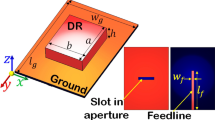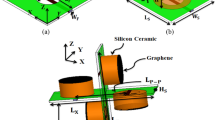Abstract
This article investigates the designing of tunable laterally and orthogonally placed MIMO antennas with enhanced isolation for THz applications. The tunability is achieved by varying the chemical potential of trapezoidal graphene-based patches loaded over the metallic patch antennas. Mutual coupling between the laterally placed MIMO antennas is mitigated by the use of defected ground structures. In the first design, a cross-shaped stub emanating out from a square shaped slot has been introduced in the ground plane for improving the isolation between the unloaded antennas without degradation of their impedance bandwidth. Introduction of a trapezoidal graphene patch over the antennas in the second design aids in conceiving tunable mutual coupling reduction. The mutual coupling has been reduced by deployment of a T-shaped stub arising from a square shaped slot in the ground plane. Orthogonally placed antennas, when separated by reflective metamaterial walls or planar metallic parasitic strip, result in improved isolation between the antennas in the frequency band of 1.6 to 3.0 THz. This configuration aids in achieving polarization diversity. A maximum isolation of 38 dB is achieved which is the highest as compared to the reported MIMO antenna designs. The envelope correlation coefficient, channel capacity loss and mean effective gain of the proposed graphene loaded antennas are within acceptable limits. The field results with several analytical results are presented for justification. The development aspect of these types of antennas has also been discussed.






















Similar content being viewed by others
References
Ahmed, F., Ghoname, R.S., AZekry, A. Mutual Coupling Reduction of MIMO Antennas using Parasitic Elements for Wireless Communications. Int. J. Comput. Appl. 62(19):39–42, (2013).
Arun, H., Sarma, A.K., Kanagasabai, M., Velan, S., Raviteja, C., Alsath, M.G.N.: Deployment of modified serpentine structure for mutual coupling reduction in MIMO antennas. IEEE Antennas Wirel. Propag. Lett. 13, 277–280 (2014)
Asaker, A., Ghoname, R., Zekry, A.: Article: Design of a Planar MIMO antenna for LTE-advanced. Int. J. Comput. Appl. 115(12), 27–33 (2015)
Cheng, Y., Ding, X., Shao, W., Wang, B.: Reduction of mutual coupling between patch antennas using a polarization-conversion isolator. IEEE Antennas Wirel. Propag. Lett. 16, 1257–1260 (2017)
Das, S., Mitra, D., Chaudhuri, S.R.B.: Fractal loaded planar super wide band MIMO antenna in THz frequency range. IEEE Asia-Pacific Microwave Conf. (APMC) 2020, 703–705 (2020)
Ding, C.F., Zhang, X.Y., Xue, C., Sim, C.: Novel pattern-diversity-based decoupling method and its application to multielement MIMO antenna. IEEE Trans. Antennas Propag. 66(10), 4976–4985 (2018)
Esfandiyari, M., Jarchi, S., Ghaffari-Miab, M.: Channel capacity enhancement by adjustable graphene-based MIMO antenna in THz band. Opt. Quant. Electron 51, 1–11 (2019)
Farahani, H.S., Veysi, M., Kamyab, M., Tadjalli, A.: Mutual coupling reduction in patch antenna arrays using a UC-EBG superstrate. IEEE Antennas Wirel. Propag. Lett. 9, 57–59 (2010)
Grossman, E., Popovic, Z.: Terahertz metrology and instrumentation. 2012 Conf. Precis. Electromagn. Meas. 2012, 264–265 (2012)
Gupta, S., Briqech, Z., Sebak, A.R., Ahmed Denidni, T.: Mutual-Coupling reduction using metasurface corrugations for 28 GHz MIMO applications. In: IEEE Antennas and Wireless Propagation Letters, vol. 16, pp. 2763–2766 (2017).
Hafezifard, R., Naser-Moghadasi, M., Mohassel, J.R., Sadeghzadeh, R.A.: Mutual coupling reduction for two closely spaced meander line antennas using metamaterial substrate. IEEE Antennas Wirel. Propag. Lett. 15, 40–43 (2016)
Jamshed, M.A., Nauman, A., Abbasi, M.A.B., Kim, S.W.: Antenna selection and designing for THz applications: suitability and performance evaluation: a survey. IEEE Access 8, 113246–113261 (2020)
Kharche, S., Reddy, G.S., Mukherjee, J., Gupta, R.K.: Mutual coupling reduction using variable length SRR like structure in ultra wideband MIMO antennas. IEEE MTT-S Int. Microwave RF Conf. (imarc) 2015, 136–139 (2015)
Lee, J., Kim, S., Jang, J.: Reduction of mutual coupling in planar multiple antenna by using 1-D EBG and SRR structures. IEEE Trans. Antennas Propag. 63(9), 4194–4198 (2015)
Liu, Y., Yang, X., Jia, Y., Guo, Y.J.: A low correlation and mutual coupling MIMO antenna. IEEE Access 7, 127384–127392 (2019)
Malik, J., Patnaik, A., Kartikeyan, M.V.: Novel printed MIMO antenna with pattern and polarization diversity. IEEE Antennas Wirel. Propag. Lett. 14, 739–742 (2015)
Ramachandran, A., ValiyaveettilPushpakaran, S., Pezholil, M., Kesavath, V.: A four-port MIMO antenna using concentric square-ring patches loaded with CSRR for high isolation. IEEE Antennas Wirel. Propag. Lett. 15, 1196–1199 (2016)
Ren, J., Hu, W., Yin, Y., Fan, R.: Compact printed MIMO antenna for UWB applications. IEEE Antennas Wirel. Propag. Lett. 13, 1517–1520 (2014)
Wei, K., Li, J., Wang, L., Xing, Z., Xu, R.: Mutual coupling reduction by novel fractal defected ground structure bandgap filter. IEEE Trans. Antennas Propag. 64(10), 4328–4335 (2016)
Xue, C., Zhang, X.Y., Cao, Y.F., Hou, Z., Ding, C.F.: mimo antenna using hybrid electric and magnetic coupling for isolation enhancement. IEEE Trans. Antennas Propag. 65(10), 5162–5170 (2017)
Xu, Z., Dong, X., Bornemann, J.: Design of a reconfigurable MIMO system for THz COMMUNICATIONS BASED ON GRAPHENE ANTennas. IEEE Trans. Terahertz Sci. Technol. 4(5), 609–617 (2014)
Zhang, S., Pedersen, G.F.: Mutual coupling reduction for UWB MIMO antennas with a wideband neutralization line. IEEE Antennas Wirel. Propag. Lett. 15, 166–169 (2016)
Zhang, S., Ying, Z., Xiong, J., He, S.: Ultrawideband MIMO/Diversity antennas with a tree-like structure to enhance wideband isolation. IEEE Antennas Wirel. Propag. Lett. 8, 1279–1282 (2009)
Zhang, B., Jornet, J.M., Akyildiz, I.F., Wu, Z.P.: Mutual coupling reduction for ultra-dense multi-band plasmonic nano-antenna arrays using graphene-based frequency selective surface. IEEE Access 7, 33214–33225 (2019)
Funding
Not Applicable.
Author information
Authors and Affiliations
Corresponding author
Ethics declarations
Conflicts of interest
No conflict of interest.
Additional information
Publisher's Note
Springer Nature remains neutral with regard to jurisdictional claims in published maps and institutional affiliations.
Rights and permissions
About this article
Cite this article
Das, P., Singh, A.K. & Mandal, K. Metamaterial loaded highly isolated tunable polarisation diversity MIMO antennas for THz applications. Opt Quant Electron 54, 250 (2022). https://doi.org/10.1007/s11082-022-03641-8
Received:
Accepted:
Published:
DOI: https://doi.org/10.1007/s11082-022-03641-8




